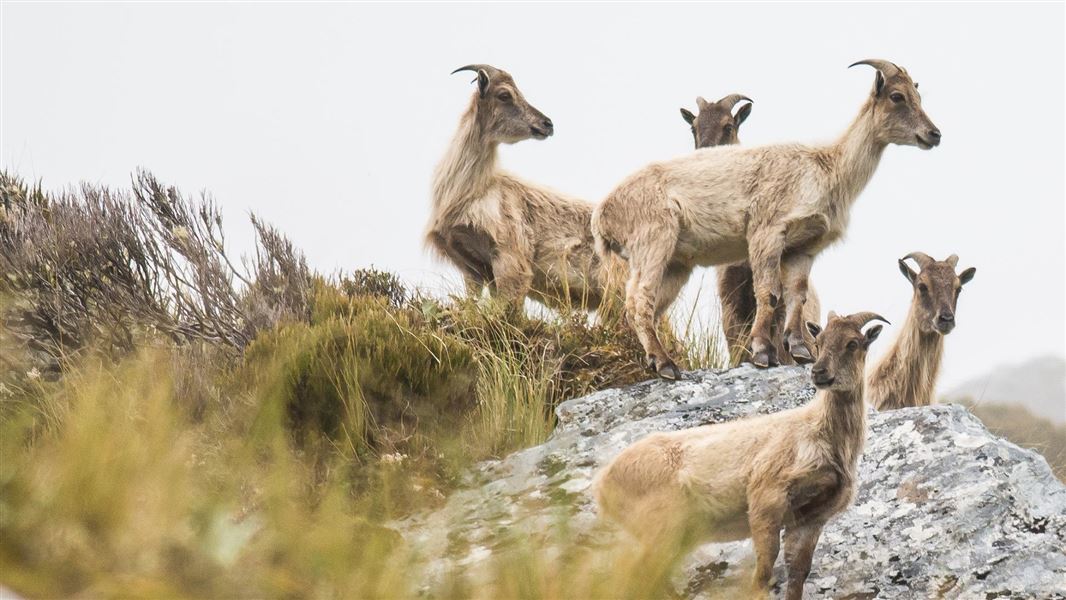Archived content: This media release was accurate on the date of publication.
Date: 10 July 2020
The New Zealand Tahr Foundation (NZTF) had filed judicial review proceedings against the Minister of Conservation and Director-General of Conservation in respect of DOC’s Tahr Control Operational Plan for 1 July 2020 to 30 June 2021.
As part of Justice Dobson’s decision, DOC is able to undertake half of its planned control programme inside of the feral range while it undertakes further consultation on the Operational Plan.
The Judge upheld only one aspect of NZTF’s complaint, which was a partial inadequacy by DOC to not provide the NZTF with the number of control hours it was proposing to undertake in a reasonable timeframe for feedback.
The judge has instructed DOC to reconsider its decision to proceed with the 2020-2021 plan after consulting with NZTF and other stakeholders. Importantly, DOC is allowed to undertake half of its proposed control as its sees fit until that consultation is completed.
DOC Operations Director Dr Ben Reddiex says the Department is pleased the Judge found DOC successfully refuted all but one of the challenges the NZTF made.
“We’re pleased we can now commence important control work across the tahr management units to protect New Zealand’s alpine environment.”
DOC’s annual Operational Plan identifies how it will implement the statutory Himalayan Thar Control Plan 1993 (HTCP), which sets a maximum population of 10,000 tahr across 706,000 ha of private land, Crown pastoral leases and public conservation land.
Dr Ben Reddiex says DOC has no plans to eradicate tahr and the Department is undertaking a phased approach to meet the objectives of the Control Plan.
“There will continue to be thousands of tahr available for hunting across 425,000 ha of public conservation land, as well as another 133,000 ha of Crown pastoral leases and private land.
“Bull tahr will only be targeted in Aoraki/Mount Cook and Westland Tai Poutini National Parks, where DOC legally needs to reduce tahr numbers to the lowest practicable density.
“We first signalled two years ago we needed to step up our tahr control efforts to protect the natural values of the national parks. We know bulls are popular with trophy hunters, but national parks are special places and they need to be protected and preserved for all New Zealanders.
“In developing the Operational Plan we engaged with all tahr stakeholders and took their views into consideration, while ensuring the final plan was consistent with the National Parks Act and other laws.
“Outside of the national parks, DOC will leave all bull tahr for recreational and commercial hunters and only target high localised densities of female and juvenile tahr.”
In Autumn 2019, the tahr population was estimated to be approximately 34,500 tahr on public conservation land alone. DOC, commercial hunters and contractors controlled approximately 11,000 tahr between July to November last year. There has since been another breeding season.
“We know there are significant populations on private land and Crown pastoral leases. There are simply too many tahr and our unique alpine ecosystems are at risk.
“Based on the planned 250 control hours, we had expected to remove approximately 7,500 tahr off public conservation land inside of the feral range over the next 12 months. The final level of control will be subject to further consultation.”
Dr Ben Reddiex says DOC’s planned control work will have a minimal effect on the commercial hunting industry, which mostly operates outside of public conservation land.
Data from trophy exports between 2014 and 2016, indicates on average, 1000 to 1100 commercially hunted bull tahr leave the country each year.
“Concession returns show just 316 trophy bull tahr are commercially hunted on the conservation estate annually, and less than a hundred of those are taken from the national parks.
“This means the vast majority of commercial hunting is taking place outside of public conservation land,” says Ben Reddiex.
DOC had planned to spend approximately $700,000 over the next 12 months controlling tahr on public conservation land as it works towards implementing the Himalayan Thar Control Plan 1993.
DOC will work with Ngāi Tahu, tahr researchers and stakeholders to establish an integrated research and monitoring programme. The programme will consider research on the adaptive management of tahr, longer term planning and tahr control.
Background
- The Himalayan Thar Control Plan 1993 is a statutory document made under section 5(1)(d) of the Wild Animal Control Act 1977.
- Tahr are social animals and group together. In extreme situations, large groups of animals can transform tall tussocks and subalpine shrublands to a grassy turf or bare ground.
- DOC aerial control operations in the seven tahr Management Units will at this stage run from July to mid-November. Operations will pause over summer when tahr kids are born.
- No tahr control will be undertaken within the feral range during the May to June tahr rut which is the busiest time for recreational hunting.
- Due to COVID-19 restrictions DOC was unable to commence work with Land Information New Zealand to survey the number of Himalayan tahr on Crown land, including pastoral leases. This aerial monitoring survey would have helped to gain a better understanding of the wider tahr population. This work is being postponed until later in the year.
Contact
For media enquiries contact:
Email: media@doc.govt.nz
